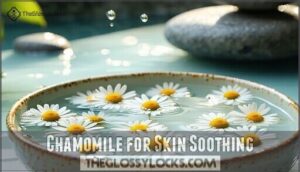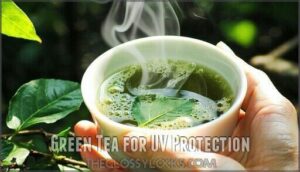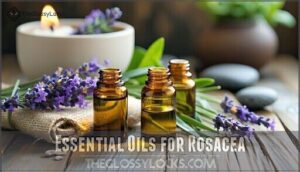This site is supported by our readers. We may earn a commission, at no cost to you, if you purchase through links.
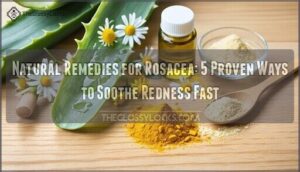 You can manage rosacea naturally through several evidence-based approaches.
You can manage rosacea naturally through several evidence-based approaches.
Aloe vera gel provides immediate cooling relief for inflamed skin, while chamomile compresses reduce redness and irritation.
Green tea’s antioxidants help protect against UV triggers when applied topically.
Gentle oatmeal masks soothe sensitive skin, and turmeric supplements may reduce overall inflammation.
Essential oils like diluted lavender can calm both skin and stress levels.
Focus on identifying your personal triggers – common culprits include spicy foods, alcohol, and extreme temperatures.
A consistent skincare routine with fragrance-free products helps maintain your skin barrier.
Stress management through meditation or yoga often reduces flare-up frequency.
These gentle alternatives work best when combined strategically.
Natural approaches, including gentle skincare routines, can help alleviate rosacea symptoms.
Table Of Contents
- Key Takeaways
- Rosacea Symptoms Explained
- Natural Remedies Overview
- Top 5 Natural Remedies
- Lifestyle Changes for Relief
- Essential Oils for Rosacea
- Rosacea Skin Care Routine
- Dietary Changes for Rosacea
- Managing Rosacea Naturally
- Frequently Asked Questions (FAQs)
- How did I heal my rosacea naturally?
- What clears up rosacea fast?
- What is the best herb for rosacea?
- What calms rosacea down?
- What foods clear up rosacea?
- What essential oil calms rosacea?
- Can probiotics help in reducing rosacea symptoms?
- Is niacinamide effective for managing rosacea?
- How can turmeric assist in treating rosacea?
- What are the benefits of drinking green tea for rosacea?
- Conclusion
Key Takeaways
- Identify your personal triggers – Keep a detailed diary to track which foods, environmental factors, or stressors cause your flare-ups, as 81% of cases are triggered by sun exposure and 79% by stress.
- Use gentle, proven topical treatments – Apply aloe vera gel, chamomile compresses, or niacinamide serums to reduce inflammation and redness without harsh chemicals that can worsen sensitive rosacea-prone skin.
- Build a consistent skincare routine – Choose fragrance-free, pH-balanced cleansers and moisturizers while always wearing broad-spectrum SPF 30+ sunscreen to protect against UV damage.
- Combine natural remedies strategically – Start with one treatment at a time to monitor your skin’s response, then layer complementary approaches like stress management techniques with anti-inflammatory foods for maximum effectiveness.
Rosacea Symptoms Explained
Rosacea affects millions of people with persistent facial redness that can look like you’re constantly sunburned, along with visible blood vessels and acne-like bumps.
Understanding your specific symptoms and triggers is the first step toward finding natural relief that actually works for your skin.
Common Rosacea Triggers
Understanding your rosacea triggers helps you avoid painful flareups before they start.
Research shows certain Environmental Factors and Dietary Culprits consistently worsen symptoms, while Stress Impact and Skincare Products create unexpected triggers for many people.
- Sun exposure triggers 81% of rosacea flareups – making UV protection your top priority
- Stress affects 79% of patients – creating a vicious cycle of symptoms and anxiety
- Alcohol causes flares in 52% of cases – with red wine being the worst offender
- Hot weather impacts 75% of sufferers – forcing many to avoid outdoor activities
Repeated flushing can lead to visible blood vessels on the face.
Facial Redness and Flushing
Rosacea’s signature facial redness resembles a persistent sunburn that won’t fade.
This burning sensation and skin sensitivity develop when blood vessels dilate near your skin’s surface. Flushing triggers vary widely—from spicy foods to emotional stress—making your face feel like it’s constantly "on fire."
Rosacea turns your face into a battlefield where every trigger feels like pouring gasoline on fire.
The psychological impact often leads people to avoid social situations, creating a cycle where embarrassment becomes another redness cause itself, fueled by the feeling of being constantly "on fire".
Visible Blood Vessels and Inflammatory Lesions
Beyond facial redness, you’ll notice spider veins appearing as fine red lines across your cheeks and nose.
These dilated blood vessels become more visible as rosacea progresses, creating a web-like pattern under your skin.
- Spider veins develop gradually and may worsen without proper rosacea natural treatment
- Acne-like breakouts appear as persistent bumps that differ from typical teenage acne
- Skin sensitivity increases dramatically, making your face react to products you once tolerated
- Burning sensations accompany flare-ups, creating discomfort that antiinflammatory approaches can help address
To combat this, consider incorporating gentle skincare routines into your daily life.
Natural Remedies Overview
Natural remedies can complement traditional rosacea treatments by targeting inflammation and irritation without harsh chemicals.
These evidence-based approaches include topical applications like aloe vera and chamomile, along with protective measures such as green tea’s UV-blocking properties, which can help reduce irritation.
Aloe Vera Gel for Reducing Inflammation
Aloe vera gel works like nature’s cooling compress for angry rosacea skin.
You’ll find its anti-inflammatory properties reduce facial redness within minutes of gel application.
The cooling effects provide immediate comfort while skin hydration improves over time.
Aloe benefits include soothing properties that calm irritated blood vessels.
Many users find relief using this gel.
Always patch-test before using aloe vera rosacea treatments, considering the immediate comfort and soothing properties it offers.
Chamomile for Skin Soothing
Chamomile works like nature’s gentle hug for your irritated skin.
This flower’s anti-inflammatory properties reduce rosacea redness and itching effectively.
You can prepare tea compresses by steeping chamomile tea, cooling it, then applying with a soft cloth.
Chamomile benefits sensitive skin by providing irritation relief without harsh chemicals.
Studies confirm chamomile rosacea treatments calm inflamed skin naturally.
Many users find chamomile-based skincare products helpful, utilizing chamomile for its soothing effects, and it provides a natural solution for sensitive skin.
Green Tea for UV Protection
Green tea creates a powerful protective barrier against UV damage through its rich antioxidant properties.
The polyphenols in green tea extracts neutralize harmful free radicals and reduce sun-related flare-ups that commonly trigger rosacea symptoms. Green tea is also known for its ability to provide skin repair from sun damage.
Here’s how green tea works:
- UV Damage Reduction – Blocks harmful rays that worsen rosacea
- Antioxidant Barrier – Shields skin from environmental stress
- Enhanced Sunscreen – Boosts your existing UV protection
Apply green tea products alongside broad-spectrum sunscreen for maximum results.
Top 5 Natural Remedies
You’ll find these five natural remedies offer scientifically-backed relief for rosacea’s persistent redness and inflammation. Each product targets specific symptoms while maintaining gentle care for your sensitive skin.
1. Seven Minerals Organic Aloe Vera Gel
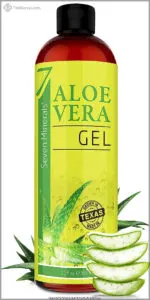
Through years of clinical research, Seven Minerals’ certified organic aloe vera gel has proven its worth for rosacea-prone skin.
You’ll find 99% pure aloe vera that’s freshly processed from Texas-grown leaves, not powder.
This gel reduces inflammation through natural polysaccharides that block inflammatory enzymes, and it hydrates deeply without clogging pores while strengthening your skin barrier.
The formula uses natural seaweed thickener, avoiding harsh chemicals that irritate sensitive skin.
Apply once or twice daily after patch testing to ensure the product works well with your skin, and enjoy the benefits of a gentle, effective skincare solution with natural polysaccharides.
Best For: People with rosacea-prone or highly sensitive skin seeking a gentle, natural solution that reduces inflammation and redness without harsh chemicals.
- Contains 99% certified organic aloe vera with natural polysaccharides that effectively reduce inflammation and soothe irritated skin
- Uses natural seaweed thickener instead of harsh chemicals, making it suitable for sensitive skin without leaving sticky residue
- Strengthens skin barrier and provides deep hydration without clogging pores, helping prevent future flare-ups
- Some users may experience skin irritation or rashes, requiring patch testing before full application
- Lacks added fragrance which some users might prefer for a more pleasant sensory experience
- May require consistent daily use over 14-56 days to see significant improvements in rosacea symptoms
2. Bianca Rosa Feverfew Salve Ointment
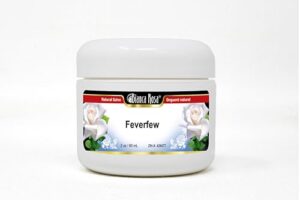
This gentle botanical remedy harnesses feverfew’s powerful anti-inflammatory compounds to calm rosacea’s angry redness.
You’ll find this parthenolide-free formula reduces inflammatory cytokines while strengthening your skin’s protective barrier.
Clinical studies show feverfew inhibits prostaglandins more effectively than aspirin, making it particularly useful for sensitive, reactive skin.
Nature’s aspirin works better than the real thing for calming angry, reactive skin.
The luxurious cream base contains jojoba oil and shea butter for added moisture.
Apply morning and evening to affected areas for best results.
Best For: People with rosacea, sensitive skin, or chronic facial redness seeking a natural anti-inflammatory treatment that strengthens the skin barrier without harsh chemicals.
- Contains parthenolide-free feverfew that’s clinically proven to reduce inflammatory compounds more effectively than aspirin
- Made with natural ingredients including jojoba oil and shea butter in a GMP-certified facility with no fillers or artificial scents
- Strengthens skin’s protective barrier while providing antioxidant benefits and mild UV protection for daily use
- Small 2 oz size may require frequent repurchasing for regular users
- Contains beeswax and lanolin-based ingredients that some people may be allergic to
- Results may take 45 days of consistent use to see significant improvement in rosacea symptoms
3. Paula’s Choice Niacinamide Pore Minimizing Serum
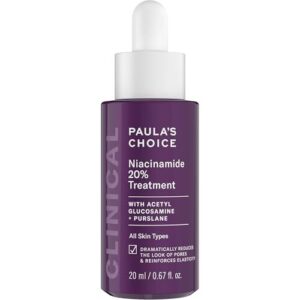
Inflammation’s persistent grip on rosacea-prone skin can feel overwhelming, but Paula’s Choice Niacinamide Pore Minimizing Serum offers targeted relief.
This 20% niacinamide formula strengthens your skin barrier while reducing redness and inflammation.
Studies show 76% of rosacea patients experienced symptom improvement after four weeks of twice-daily use.
The serum also minimizes pore appearance and evens skin texture without irritating sensitive skin.
Consistent use of the serum can also help with long-term skin benefits.
You’ll need only small amounts per application, making this investment last months while delivering visible results within 2-4 weeks.
Best For: People with rosacea-prone skin seeking to reduce inflammation, strengthen their skin barrier, and minimize pores without irritating sensitive skin.
- Expensive compared to alternatives, which can be a barrier for repurchase
- Some users experience irritation or find the texture sticky with poor absorption
- High concentration may be too strong for daily use for some sensitive skin types
- Clinical evidence shows 76% of rosacea patients experienced symptom improvement with twice-daily use
- High 20% niacinamide concentration effectively strengthens skin barrier and reduces redness within 2-4 weeks
- Small amount needed per application makes the product last months despite higher price point
4. Dirty Treasures Oatmeal Eczema Bath
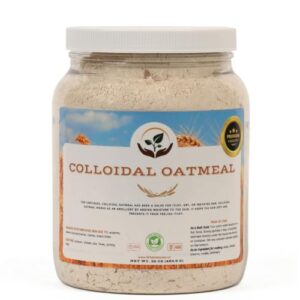
Comfort takes on new meaning when colloidal oatmeal meets your irritated skin.
This 100% natural powder dissolves into bath water, creating a soothing soak that calms rosacea’s angry redness.
Clinical trials show it restores your skin barrier by 52%, locking in moisture while reducing inflammation.
You’ll add one tablespoon to warm water and soak for 15-20 minutes.
It’s fragrance-free and safe for daily use, making it perfect for sensitive skin that can’t handle harsh treatments, providing a soothing soak and helping with rosacea’s angry redness.
Best For: People with rosacea, eczema, or sensitive skin seeking a natural, fragrance-free bath treatment that provides gentle daily relief from inflammation and dryness.
- Clinically proven to restore skin barrier function by 52% while reducing inflammation
- 100% natural colloidal oatmeal that’s fragrance-free and safe for daily use on sensitive skin
- Versatile application for baths, DIY skincare recipes, and suitable for all ages including infants
- Requires thorough bath cleaning after use to prevent residue buildup
- Ultra-fine powder may need extra mixing to dissolve completely in bath water
- Large bulk packaging size may not be convenient for occasional users
5. Turmeric Curcumin with Ginger and Bioperine
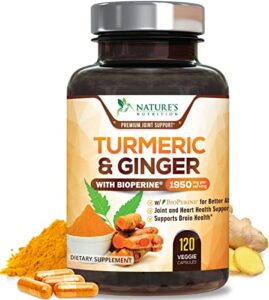
Powerful turmeric curcumin supplements offer promising relief for rosacea’s stubborn redness.
Clinical studies show turmeric reduces facial inflammation by 40% when combined with complementary ingredients.
The secret lies in bioavailability—curcumin alone gets poorly absorbed, but adding BioPerine (black pepper extract) increases absorption by 2,000%.
Ginger amplifies anti-inflammatory effects, targeting the root causes of flare-ups.
Take with meals to prevent stomach upset and maximize benefits.
Best For: People with rosacea seeking natural anti-inflammatory relief, especially those who want enhanced absorption and complementary ingredients for maximum effectiveness.
- Clinically proven 40% reduction in facial redness when combined with complementary ingredients
- Enhanced bioavailability with BioPerine increasing curcumin absorption by up to 2,000%
- Triple-action formula with turmeric, ginger, and black pepper extract targeting multiple inflammation pathways
- May cause stomach upset or heartburn if taken on empty stomach
- Requires multiple daily capsules and consistent dosing with meals for optimal results
- Not recommended for those with blood clot disorders, liver disease, or gallstones without medical consultation
Lifestyle Changes for Relief
Beyond topical treatments, simple lifestyle adjustments can substantially reduce your rosacea flare-ups and help you regain control over your skin.
Managing stress, protecting yourself from UV exposure, and identifying dietary triggers are three powerful strategies that work alongside natural remedies to keep symptoms at bay.
These strategies, including managing triggers, can help you keep your rosacea symptoms under control and improve your overall skin health.
Stress Management Techniques for Rosacea
Beyond topical treatments, managing stress can dramatically reduce rosacea flare-ups.
Since stress triggers symptoms in 91% of patients, developing coping strategies becomes your secret weapon against inflammation.
Proven stress management techniques for clearer skin:
- Mindfulness meditation – Just 5 minutes daily calms your nervous system and reduces cortisol spikes
- Breathing exercises – Deep breathing during stressful moments prevents immediate flare-ups
- Yoga benefits – Gentle poses improve flexibility while naturally lowering stress hormones
- Journaling prompts – Writing about triggers helps identify patterns and emotional responses
- Support groups – Connecting with others facing similar challenges reduces isolation and anxiety
To enhance your meditation practice, consider using a helpful meditation resource.
Dietary Changes to Reduce Rosacea Symptoms
Food-trigger identification becomes your detective work when managing rosacea symptoms.
Keep a detailed food diary to spot patterns between meals and flare-ups. Common rosacea trigger foods include spicy dishes, alcohol, hot beverages, and citrus fruits.
An elimination diet helps pinpoint personal triggers while emphasizing antiinflammatory diet choices like omega-3 rich fish and leafy greens.
Sugar reduction supports gut health, and probiotic benefits include improved skin barrier function. Hydration importance can’t be overstated for maintaining healthy skin.
Sun Protection for Preventing Flare-Ups
UV radiation stands as your skin’s biggest enemy when managing rosacea.
Sun exposure triggers inflammatory responses that worsen redness and irritation.
Here’s your protection strategy:
- Apply broad-spectrum sunscreen with SPF 30+ daily, even indoors
- Wear protective clothing like wide-brimmed hats during peak sun hours (10 AM-4 PM)
- Choose physical sunscreens containing zinc oxide for sensitive rosacea-prone skin
Your sun sensitivity increases with rosacea, making consistent UV protection non-negotiable for symptom control.
Essential Oils for Rosacea
Essential oils can provide targeted relief for rosacea symptoms, but they require careful dilution and patch testing to avoid skin irritation.
When used properly, certain oils like lavender, tea tree, and licorice root extract offer anti-inflammatory and antimicrobial benefits that may help calm your reactive skin, providing anti-inflammatory benefits.
Lavender Oil for Reducing Stress
Lavender aromatherapy offers natural stress reduction for rosacea sufferers.
This calming essential oil helps improve sleep quality and provides anxiety relief, which can minimize stress-triggered flare-ups.
Always practice proper oil dilution—mix a few drops with carrier oil before applying to skin.
While lavender oil for rosacea shows promise in stress management, patch test first to avoid sensitivity reactions.
Tea Tree Oil for Antimicrobial Properties
When dealing with rosacea’s underlying causes, tea tree oil’s antimicrobial properties target Demodex mites that trigger inflammation.
Clinical studies show proper dilution methods (0.5-3%) reduce mite density substantially, and application techniques require patch testing first, then gentle massaging into affected areas.
While mite reduction and inflammation control improve symptoms, side effects like irritation can occur without proper dilution.
Licorice Root for Inflammation Reduction
Licorice extract contains glycyrrhizin, a powerful compound that tackles inflammation head-on.
Research findings show this natural remedy’s anti-inflammatory properties can calm irritated rosacea skin when applied topically. You’ll want to dilute licorice extract properly before use, as concentrated forms may irritate sensitive skin.
Internal consumption through supplements offers additional benefits, but consult your doctor first to avoid interactions with medications. Consider using aloe vera gel to further soothe the skin.
Rosacea Skin Care Routine
Creating a gentle skincare routine specifically for rosacea-prone skin can substantially reduce flare-ups and keep your complexion calm.
You’ll need to focus on non-irritating products that cleanse without stripping your skin’s natural protective barrier while providing targeted treatment for redness and sensitivity.
Gentle Cleanser for Rosacea
Choose a gentle rosacea cleanser with ceramides and niacinamide ingredients that maintain your skin’s pH balance around 5.5.
Apply using lukewarm water with gentle circular motions, avoiding harsh rubbing.
Cleanse twice daily maximum to prevent over-stripping sensitive skin.
Look for fragrance-free, sulfate-free formulas specifically designed for rosacea friendly skincare routines.
Rosacea Cream for Face
After establishing your cleansing routine, selecting the right rosacea cream for face becomes your next priority. Look for products containing proven cream ingredients like niacinamide, azelaic acid, and botanical extracts that target redness without irritation.
Consider these application techniques for maximum cream effectiveness:
- Patch test new products on your inner wrist before facial application
- Apply thin layers twice daily to clean, dry skin using gentle upward motions
- Layer moisturizer over prescription creams to prevent dryness and enhance comfort
- Choose fragrance-free formulations with green color neutralizers for immediate redness relief
Whether you opt for prescription creams or DIY creams, consistency matters most. Aloe vera rosacea treatments and chamomile rosacea formulations offer gentle, natural alternatives. Your rosacea friendly skincare routine should prioritize barrier restoration while delivering targeted rosacea redness relief through evidence-based ingredients.
Dietary Changes for Rosacea
What you eat can dramatically impact your rosacea symptoms, making the difference between constant flare-ups and clear, comfortable skin.
By keeping a food diary and identifying your personal triggers, you’ll discover which foods worsen your redness and which ones actually help calm inflammation.
Identifying and Eliminating Trigger Foods
Beyond gentle skincare lies your plate’s impact on rosacea. Tracking trigger foods through a Dietary Diary reveals personal patterns.
An Elimination Diet systematically removes suspected Inflammatory Foods for 2-4 weeks, then reintroduces them individually. This approach identifies Hidden Allergens affecting Gut Health and skin inflammation.
| Common Trigger Foods | Reaction Timeline | Alternative Options |
|---|---|---|
| Spicy foods (61% of patients) | 30 minutes to 2 hours | Mild herbs like basil, oregano |
| Alcohol, especially red wine | Immediate to 1 hour | Sparkling water with fruit |
| Hot beverages | During consumption | Iced versions of favorite drinks |
| Dairy products | 2-24 hours | Plant-based milk alternatives |
| Citrus fruits | 1-4 hours | Low-acid fruits like bananas |
Your food diary should note symptoms, timing, and severity. This systematic approach helps distinguish true triggers from coincidental flare-ups, supporting effective rosacea diet tips and antiinflammatory diet planning.
Anti-Inflammatory Foods for Rosacea
Your rosacea antiinflammatory diet should focus on foods that calm inflammation rather than trigger flare-ups.
These antiinflammatory foods support gut health while providing natural remedies for sensitive skin.
- Leafy greens like kale and spinach pack antioxidant sources that fight inflammation
- Fatty fish such as salmon deliver omega-3 benefits for healthier skin
- Colorful berries provide powerful antioxidants to reduce redness naturally
- Avocados offer healthy fats that support your skin’s protective barrier
- Ginger and turmeric act as natural anti-inflammatory powerhouses for your rosacea diet tips
Omega-3 Rich Foods for Inflammation
Several fatty fish provide powerful Omega-3 Benefits for reducing rosacea inflammation.
Fatty Fish like salmon contains EPA and DHA that calm irritated skin.
Flaxseed Power delivers plant-based omega-3s, while Chia Seeds offer similar benefits.
The Walnuts Impact shouldn’t be overlooked either.
These antiinflammatory foods support your rosacea antiinflammatory diet alongside leafy greens.
| Omega-3 Rich Foods | Serving Size |
|---|---|
| Wild salmon | 3.5 oz |
| Sardines | 3 oz |
| Flaxseeds (ground) | 2 tablespoons |
| Chia seeds | 1 tablespoon |
| Walnuts | 1/4 cup |
Managing Rosacea Naturally
You can take control of your rosacea symptoms by combining proven herbal remedies with simple lifestyle adjustments that target inflammation at its source.
Managing this condition naturally requires a consistent approach that includes both topical treatments and stress-reducing activities to prevent flare-ups before they start.
Herbal Anti-Inflammatories for Rosacea
Beyond dietary adjustments, herbal anti-inflammatories offer targeted relief through specific mechanisms.
These natural compounds work by inhibiting inflammatory pathways that trigger rosacea flare-ups.
Key herbal options include:
- Licorice root extract – Contains glabridin that blocks inflammatory cytokines like TNF-α and IL-1
- Chamomile formulations – Apigenin reduces erythema and skin irritation through anti-inflammatory action
- Green tea polyphenols – Provide UV protection while decreasing oxidative stress and DNA damage
- Feverfew preparations – Parthenolide-free extracts improve facial flushing and skin texture
- Yarrow oil macerations – Flavonoids balance skin pH and reduce irritation within days
Extraction techniques and formulation methods affect potency.
Combination therapies often prove more effective than single herbs.
Many users are shifting organic herbal products.
Always patch test new preparations, as safety profiles vary between individuals.
Exercise for Reducing Stress and Inflammation
Regular physical activity works like a double-edged sword against rosacea flare-ups.
Exercise benefits include natural stress relief and inflammation reduction through endorphin release.
Choose low-intensity exercise types like walking, yoga, or swimming during cooler hours.
Mind-body practices such as meditation and deep breathing enhance routine consistency while preventing heat-triggered episodes that worsen symptoms.
Frequently Asked Questions (FAQs)
How did I heal my rosacea naturally?
Dramatically transforming your rosacea won’t happen overnight, but you’ve likely found success through gentle aloe vera applications.
Stress management techniques, identifying personal triggers, consistent sunscreen use, and anti-inflammatory foods like ginger are also important.
These methods, when used consistently, can help in managing rosacea.
What clears up rosacea fast?
You can’t truly "clear up" rosacea fast since it’s chronic, but gentle topical treatments like aloe vera, niacinamide, or green tea extracts help reduce redness quickly.
What is the best herb for rosacea?
Like ye olde apothecaries knew, chamomile reigns supreme for rosacea relief.
You’ll find this gentle herb reduces redness, itching, and inflammation when applied as cooled compresses or in moisturizers.
Always patch-test first.
What calms rosacea down?
Gentle skincare with soothing ingredients like aloe vera, chamomile, and niacinamide helps calm rosacea flare-ups. You’ll also benefit from stress management, sun protection, and avoiding personal triggers.
What foods clear up rosacea?
Looking for foods that’ll help your skin find peace?
Anti-inflammatory options like kale, ginger, and avocados support skin health.
You’ll need to identify personal dietary triggers through food diaries for effective rosacea management.
What essential oil calms rosacea?
Tea tree oil can calm rosacea when properly diluted, but you’ll need professional guidance.
Lavender oil also shows anti-inflammatory properties.
Always patch test first and dilute essential oils substantially to avoid worsening irritation.
Can probiotics help in reducing rosacea symptoms?
Probiotics might help reduce rosacea symptoms by supporting gut health and reducing inflammation.
Some studies suggest they can improve skin barrier function.
However, research is limited and results vary between individuals, so consult your dermatologist first to discuss the potential benefits of probiotics.
Is niacinamide effective for managing rosacea?
Yes, niacinamide is effective for rosacea management. Studies show 2% niacinamide in moisturizers improves skin barriers, reduces redness, and strengthens your skin’s protective function, making it gentler than many alternatives.
How can turmeric assist in treating rosacea?
Turmeric reduces rosacea’s redness and inflammation through its anti-inflammatory properties. You can apply turmeric creams or create a gentle poultice, but always patch-test first to avoid potential skin sensitivity reactions.
What are the benefits of drinking green tea for rosacea?
Drinking green tea provides antioxidants that help protect your skin from UV damage and reduce inflammation internally.
However, topical green tea application offers more direct benefits for rosacea symptoms than consuming it orally.
Conclusion
Like Rome wasn’t built in a day, your journey to clearer skin requires patience and consistency.
These natural remedies for rosacea offer proven relief when used strategically together. Remember that everyone’s skin responds differently, so you’ll need to identify your personal triggers while building an effective routine.
Start with one remedy at a time to monitor your skin’s response. With dedication and the right combination of treatments, you can achieve the calmer, healthier complexion you deserve.
- https://www.medicalnewstoday.com/articles/rosacea-natural-treatments
- https://pubmed.ncbi.nlm.nih.gov/16468289/
- https://cdn.mdedge.com/files/s3fs-public/issues/articles/Vol30_i3_Emer.pdf
- https://health.clevelandclinic.org/rosacea-natural-treatments
- https://aanmc.org/naturopathic-medicine/treatments-supplements-for-rosacea/





